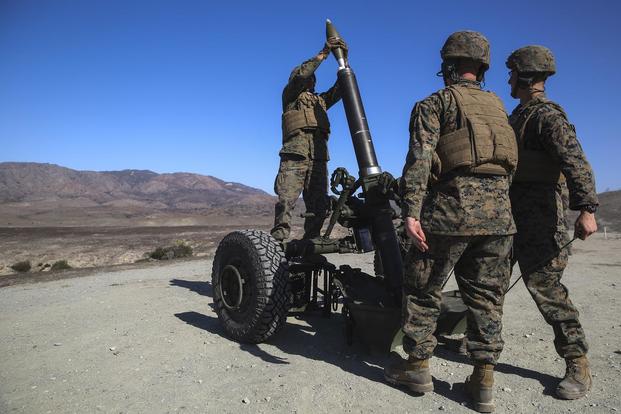In a push to build its modernization budget and invest in new technologies, the Marine Corps has hauled at least one program of record to the curb -- and is looking for more to cut.
The Corps has already divested of the 120mm Expeditionary Fire Support System to make way for other capabilities, Lt. Gen. Robert Walsh, commanding general of Marine Corps Combat Development Command, told Military.com in an interview.
The EFSS, fielded in the early 2000s, was designed to be extremely portable, small enough to be towed by an all-terrain vehicle that fits easily inside an MV-22 Osprey.
Made by General Dynamics, the full system weighs roughly 18 pounds and can fire high-explosive, smoke and illumination rounds. The system was fired in combat for the first time in 2011.
The news that the Marine Corps is cutting ties with the program is something of a surprise, considering the service was in the process of acquiring a new round: the Raytheon-made GPS-guided precision extended range munition, or PERM, expected to increase the accuracy of the system and extend its range from roughly five miles to 10.
In 2015, Raytheon inked a $98 million contract with the Corps for the delivery of PERM; the round was to have been fielded to Marine units next year.
But Walsh said the Marine Corps is working to extend the range of its artillery arsenal, particularly its M777 howitzer. With its limited range, the EFSS may not be well suited to what Marine leaders perceive as the Corps' future mission.
"We made that decision to divest of it, and we're going to move that money into some other area, probably into the precision fires area," Walsh said. "So programs that we see as not as viable, this [program objective memorandum] development that we're doing right now is to really look at those areas critically and see what can we divest of to free money up to modernize."
Walsh said the Marine Corps wants to see a boost of about 5 percent in its modernization budget. The just-passed Fiscal 2018 National Defense Authorization Act included a modest bump in procurement, with much of the additional money earmarked for investment in ground vehicles.
As the Corps plans for 2020 and beyond, Walsh said the service is looking inside the organization to find savings and "investment trade-offs" in order to get the money it needs.
While Walsh said he could not yet identify other Marine Corps programs that had been marked for divestiture, he noted that operations and maintenance funding may also be examined in order to move more money into modernization.
"The commandant has told us ... I wouldn't say that he has modernization over readiness -- readiness is important -- but he's told us to look real hard at our ops and maintenance accounts that aren't tied specifically to unit readiness," he said.
"We can look ... to determine across the [Marine Air-Ground Task Force] where we can find money and move it into the modernization area to get that slope up higher within the Marine Corps," Walsh said.
-- Hope Hodge Seck can be reached at hope.seck@military.com. Follow her on Twitter at @HopeSeck.










